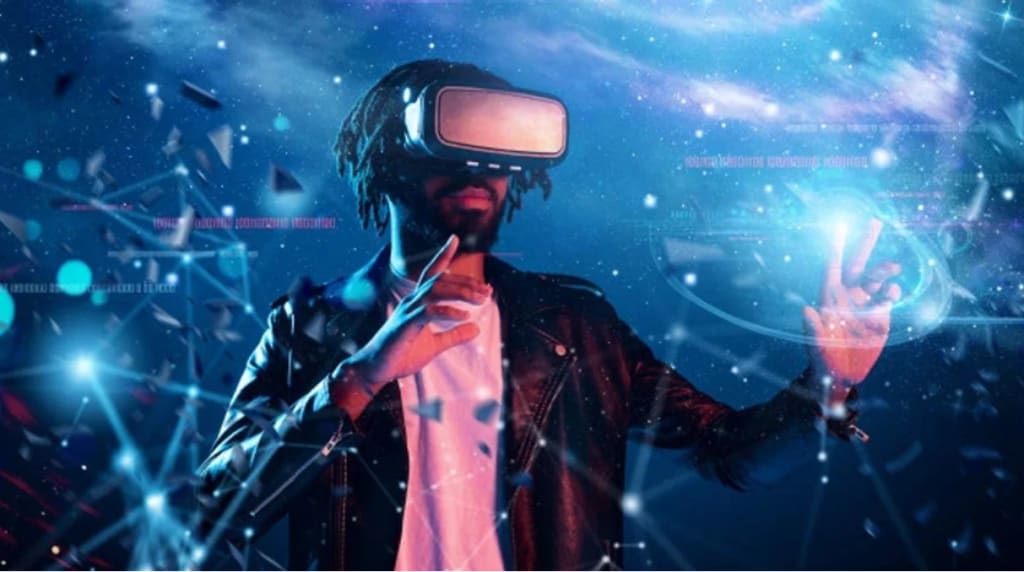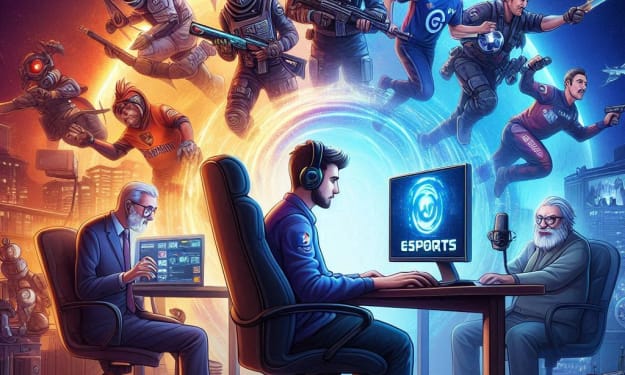What Does the Future of Gaming Look Like?
The future games will be dominated by “Virtual Reality”. Though, many games and videos are available now but they still need development.

ideo games have steadily risen in popularity for years. And with people looking for new ways to socialize and stay entertained during the pandemic, the trend has only accelerated. Gaming is now a bigger industry than movies and sports combined.
Revenue for gaming grew 12 percent in 2020, up to $139.9 billion from $120.1 billion in 2019, according to a report by market research firm SuperData. And at one point last year, four out of every five people in the United States had played a video game within the previous six months.
“It used to be ‘what to watch’ and now it’s ‘whether to watch,’” venture capitalist Matthew Ball wrote. “And the answer is increasingly ‘no, I’m going to play a game.’”
So what’s next? Culturally, gaming will only continue to become more mainstream. But what tech innovations are shaping the future of video games, and how will they influence the gaming experience?
Virtual Reality
For decades, virtual reality has tantalized gamers with the prospect of a fully immersive experience. But the technology has been slow to deliver on that promise.
Polygon’s Ben Kuchera put it bluntly last year: “VR has been five minutes away from some kind of breakthrough for about eight years.”
VR is still a niche category when compared to the rest of e gaming industry (it accounted for less than half a percent of all gaming sales in 2020). And despite its buzzy status, it continues to give many consumers pause.
“Right now we’re sort of in this trough of disillusionment about VR,” Kevin Mack, a VR game developer, told Built In in 2020. “There was a lot of hype around it in 2015 and 2016, and then the whole world sort of got butt-hurt that their first-generation VR headset didn’t instantly morph into the Holodeck.”
“The whole world sort of got butt-hurt that their first-generation VR headset didn’t instantly morph into the Holodeck.”
Although VR has yet to live up to the hype, tech companies like Facebook, Valve and Sony are busy trying to advance the industry, investing considerable resources to develop VR hardware and games.
Augmented Reality
In the summer of 2016, parks and plazas swarmed with smartphone-wielders on Pokémon-catching missions.
The masses were playing Pokémon Go, an augmented reality mobile game in which digital objects — in this case, colorful critters called Pokémon — overlay a person’s natural field of view.
The game, which has since generated over $5 billion in sales, was most people’s first brush with AR and remains the technology’s biggest success story.
But the long-term success of Pokémon Go is due only in part to its beloved intellectual property. There are plenty of other games and books and movies in which people can spend time with Ash Ketchum and Pikachu. The real secret sauce is the game’s blend of virtual and real, the interplay between digital characters and physical locations.
That’s partly why AR is taking off faster than VR: People have an appetite for games that interact with reality, not remove them from it.
“I think the entertainment experiences in AR aren’t going to try to be immersive experiences,” Mack said. “When I was playing [Pokémon Go], I would go to specific places just because there was a Pokémon there. And that’s a powerful social driver.”
Artificial Intelligence
The idea of artificial intelligence has been expressed in gaming for decades — most prominently in non-player characters, like the colorful ghosts in Pac-Man or the innocent bystanders in Grand Theft Auto.
In recent years, gamemakers have taken a more sophisticated approach to NPCs. Many NPCs are now programmed with behavior trees, which allow them to perform more complex decision-making. The enemy aliens in Halo 2, for example, have the ability to work together and coordinate their attacks, rather than heedlessly beeline into gunfire one by one like they’re in a cheesy action movie.
In other words, even if we could give NPCs minds of their own and let them run free in games, odds are that their autonomy would result in a less fun experience for the player. A rogue NPC could decide to shirk its duty to help the player advance toward the next level or take the player on a nonsensical quest where nothing happens.
“Games are a pretty conservative industry, in terms of the willingness that publishers or studios have to take risks.”
In addition to presenting game design challenges, free-range NPCs may be a non-starter when considered from a purely economic perspective as well.
“Imagine what it would mean to have an AI ‘director’ who’s looking at what you’re doing and directing the unfolding experience for you,” he said. “That’s kind of like what my research is trying to do and what a lot of interesting work in the field — not just me — is trying to do.”
“Imagine what it would mean to have an AI ‘director’ who’s looking at what you’re doing and directing the unfolding experience for you.”
Cloud Gaming
The future of gaming might take place on someone else’s computer. That is to say, in the cloud.
Cloud gaming offers users the ability to play video games streamed from tech companies’ faraway servers, in the same way they stream Netflix movies on their laptops without needing to pop in a DVD first.
In theory, this arrangement makes the gamer’s local hardware less relevant — they can stream the games regardless of their device.
And since cloud gaming is typically pitched as a subscription service, it’s moving gamers away from a mentality of owning physical media and toward one of renting digital content.
In the past couple of years, Sony and Microsoft, which have long been the console gaming incumbents, have rolled out their own cloud gaming services. Gaming chipmaker Nvidia has too.
Even Big Tech is getting in on the action. Google released its cloud gaming service, Stadia, in 2019. And Amazon debuted its cloud gaming offering — called Luna — in 2020. Even Netflix — which, up to this point, has only made movies and TV shows — has shown signs of getting into cloud gaming. The company recently hired its first vice president of gaming.
But the biggest hurdle cloud gaming needs to clear in order to become truly mainstream is to be able to offer a smooth, non-laggy gaming experience for users. And that sort of experience is hard to come by for anyone without a great WiFi connection.
Not only that, running a cloud gaming service is costly and computationally intensive. So getting the technology right will take time.
In 2019, Xbox head Phil Spencer told GameSpot as much: “I think this is years away from being a mainstream way people play. And I mean years, like years and years.”h
High-Fidelity Graphics
In the pursuit of ultra-realistic graphics, video games have come a long way.
PC gaming companies like Nvidia and AMD have made great strides in creating graphics cards that allow for high-fidelity gaming and techniques like ray tracing.
In the past, things like shadows and reflections and lens flares were essentially painted onto objects within the game. This gave the illusion that light was coming from the sun or moon and reacting as it would when it hit a surface. With ray tracing, an algorithm basically allows it to actually do just that.
The technology is expected to be a game changer — if only consumers are able to get their hands on it. A chip shortage has plagued the industry for much of 2020 and 2021. That’s mostly due to the sudden rise in popularity of cryptocurrency mining, which relies on the same hardware.
But not all games of the future will be designed for such realistic graphics. Especially not indie games.
The way Mack sees it, there are two distinct routes game developers can take when it comes to graphics.
One approach is what you see happening in major triple-A games, which is to hire tons of visual artists and technicians to supply vast amounts of art for high-fidelity graphics. That means big budgets, big teams and increasingly realistic graphics, down to every last speck of dirt.
The other approach is to produce a more stylized — in some cases cartoonish — aesthetic for your game. That way, the costs stay down but the game still looks cool and dodges the criticism: “It doesn’t look realistic!” Mack said this approach is becoming more and more common in the mobile VR space.
The Metaverse
No discussion of the future of gaming would be complete without mentioning the metaverse, a theoretical concept that has dazzled many of the world’s foremost tech companies.
A concept popularized by author Neal Stephenson in his 1992 science-fiction book Snow Crash, the metaverse is best understood as an online cyberspace, a parallel virtual realm where everyone can log in and live out their (second) lives. Ideally, the metaverse will combine both virtual and augmented reality, have its own functioning economy and allow complete interoperability.
While we may be a long way off from that, hints of the metaverse are increasingly evident. You see it in gaming platforms like Roblox, where luxury fashion brands like Gucci host events, and in games like Fornite, where users can dress up as their favorite Star Wars or Marvel characters and watch virtual Ariana Grande concerts.
The metaverse, like the internet, will be used for more than just gaming. It may incorporate office work as well.
But gaming itself is expanding its definition. It’s no longer about competition — but connection. It’s what Keith Stuart describes as a “digital third place,” more closely resembling a skate park than an arena.
If the current trends and future forecasts of the gaming industry clue us into anything about ourselves, it’s that our desire to connect far outpaces our desire to escape.
About the Creator
Enjoyed the story? Support the Creator.
Subscribe for free to receive all their stories in your feed. You could also pledge your support or give them a one-off tip, letting them know you appreciate their work.





Comments
There are no comments for this story
Be the first to respond and start the conversation.